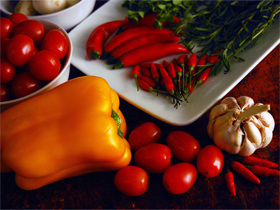You’ve read all the benefits of eating a raw diet, which include the following:
• Increased energy
• Decreased risk of developing cardiovascular disease
• Improved digestion
• Weight loss
• Decreased doctor’s office visits
• Enhanced skin appearance
So you’ve found out about the benefits and have decided that you want to adopt a raw food diet.
Now you have to figure out what to buy and where and how to buy it. You could just head down to the local Piggly Wiggly or Food Lion and see what looks good in the produce section, but how can you be sure you are getting the best fruits and vegetables? Should you only be sticking in the produce aisle? Do you need to be looking for certain labels such as “organic”? Are there other options? Will going raw blow your budget?
There are many online tools that can help answer all those questions and get you well on your way to eating delicious and healthy meals without spending too much green. Just remember these tips before diving in:
1. Be organic-aware. Ultimately, everything we put into our bodies should be free of pesticides and dangerous chemicals. Wouldn’t it be awesome if our bodies had their own security systems to warn us before we buy anything tainted with man made toxins? And wouldn’t it be even more awesome if our wallets created more money whenever we chose organic items? The sad reality is that organic produce can be a burden on the budget—and our immune system simply won’t wave a red flag when we reach for a veggie that’s laden with toxins. The Environmental Working Group has created lists of fruits and vegetables that contain the most pesticides and those that are safer to buy non-organic. When organic items are available, be certain that they are what they claim to be by learning about labels. Before you begin writing your shopping list, keep in mind that you should…
2. Buy local. Local produce doesn’t have to travel too far to get to your table, so less fuel was required and less pollution was generated during its transport. It also means that it is less likely to be treated with chemicals to keep it looking fresh. The National Resources Defense Council site’s interactive map lets you select a state and a time of year to find out what’s growing on farms near you. Which brings up another tip…
 3. Buy seasonal. If the current climate is optimal for growing a crop, then it is less likely that artificial means will be used to make that crop appear fresh on the shelf–and just because it looks fresh doesn’t mean that it tastes fresh or has all the nutrients that a truly fresh fruit or vegetable should have, even though those too-red-to-be-true tomatoes may cost less than the misshapen blobs from the farm down the road. If you can’t get items you need locally, do stick to items that are grown in season. One good way to ensure you are getting something in season is to buy at a…
3. Buy seasonal. If the current climate is optimal for growing a crop, then it is less likely that artificial means will be used to make that crop appear fresh on the shelf–and just because it looks fresh doesn’t mean that it tastes fresh or has all the nutrients that a truly fresh fruit or vegetable should have, even though those too-red-to-be-true tomatoes may cost less than the misshapen blobs from the farm down the road. If you can’t get items you need locally, do stick to items that are grown in season. One good way to ensure you are getting something in season is to buy at a…
4. Farmers’ market. Though farmers’ markets may not offer the widest selections or lowest prices, you might be able to haggle with a vendor–especially if you are buying in quantity. Though a growing number of communities are tightening regulations to allow only local farms to sell at farmers’ markets, check the credentials of vendors whose products interest you. If there are no markets near you, or none are open when you have time available, join a…
5. CSA. Community Supported Agriculture is an excellent way to buy seasonal food from local farmers, and it couldn’t be easier to budget: At the beginning of each growing season, members pay a fixed amount, and each week they get (either delivered or picked up) a quantity of mixed produce (some farms also offer meat, eggs, and other items). CSAs offer advantages for buyers in the form of freshness, variety (you may receive fruits and vegetables that you’ve never even heard of!), and convenience. Farmers get paid at the beginning of a season, which gives them capital with which to farm. The rest of the world benefits from less pollution. Before you let the farmer get back to sowing and harvesting, ask her how long that mao qua will keep in the crisper, because it is crucial that you always…
6. Know the shelf life of your produce. Every fruit and vegetable has requirements for storage and a time limit under optimal conditions. Write your shopping lists and plan your meals with the shelf life of ingredients in mind. It helps to be flexible and to open your palette to what nature provides from season to season; if you have your heart set on gazpacho in January, either settle for less flavor and more chemicals, or challenge your taste buds with a Thai slaw.
These six tips are just a few ways that you can ensure that your raw diet doesn’t cost you an arm and a leg—or keep you up at night!
Eating a raw diet may require some changes in how and where you do your grocery shopping, but like the diet itself, these changes will improve your life.
